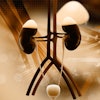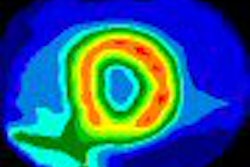A multicenter clinical trial presented today at the American College of Cardiology (ACC) meeting in Chicago has found that 64-slice coronary CT angiography (CTA) is less costly than SPECT myocardial perfusion imaging in patients without a prior diagnosis of coronary artery disease (CAD).
Dr. James Min from New York-Presbyterian Hospital and Weill Medical College of Cornell University in New York City reported that the average per-patient cost of diagnosis with CTA was $603 less than diagnosis with nuclear SPECT imaging.
"These are exciting data," Min said in a statement. "This provides an initial foundation to suggest that CCTA may be used as a cost-efficient alternative to nuclear stress testing for evaluation of patients with suspected coronary artery disease."
The researchers examined claims from health plans covering more than 10 million individuals, using ICD-9 codes to identify 142,535 patients with suspected coronary artery disease who underwent either coronary CTA or SPECT. Data was matched to 2,313 patients undergoing CTA, and 9,252 undergoing SPECT imaging (for both exams mean age 53, 41.5% female, 10.6% with diabetes mellitus, 40% hypertension, 52.5% hyperlipidemia, 16.2% known CAD), and five other risk factors.
Patient costs and outcomes were tracked for nine months before and after the exam. Cardiac risk was assessed based on each patient's risk factors and medications. The investigators calculated the costs of coronary artery disease after both tests, and recorded any adverse events including myocardial infarction, angina, and hospitalizations related to coronary artery disease, according to the study abstract.
After multivariate adjustment, the downstream costs of coronary artery disease for patients without a prior CAD diagnosis were lower in CTA patients by $603 (95% confidence index [CI] $244-$2,053, p < 0.001) compared to the SPECT group. For the 16.2% of patients with known CAD, however, costs were lower in the SPECT group by $2,451 (95% CI $1,474-$4,068, p < 0.001) compared to CTA.
There were no significant differences between CTA and SPECT in myocardial infarction rates (0.7% versus 0.8%), incident angina (3.8% versus 4.0%), or CAD-related hospitalizations (0.2% vs. 0.2%), Min and colleagues reported.
These results suggest that cardiac CTA is more cost-effective in patients without a prior CAD diagnosis, while SPECT retains a cost advantage in patients with known coronary artery disease, Min concluded.
Related Reading
Cardiac CT saves money and time as first-line heart test, April 1, 2008
Copyright © 2008 AuntMinnie.com



















